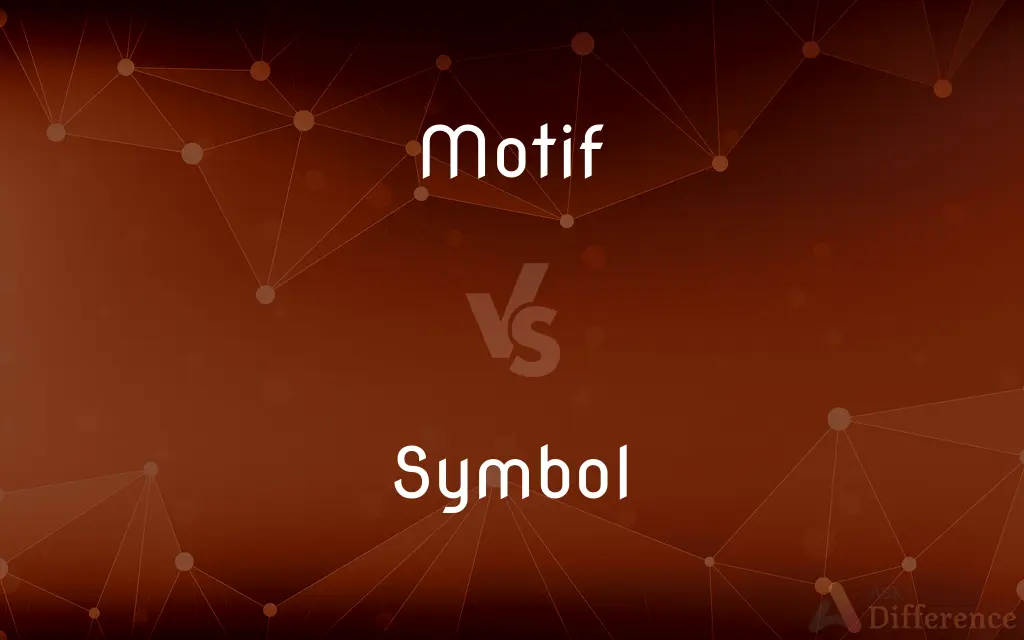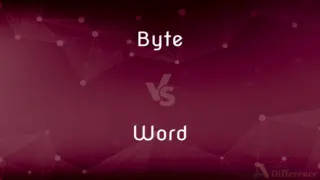Motif vs. Symbol — What's the Difference?
By Tayyaba Rehman & Urooj Arif — Updated on March 15, 2024
A motif is a recurring element or idea in a work of art that develops or explains a theme, often setting the tone or mood, while a symbol is a specific object, character, or event that stands for a larger idea or concept, conveying deeper meanings.

Difference Between Motif and Symbol
Table of Contents
ADVERTISEMENT
Key Differences
Motifs are recurring structures, contrasts, or literary devices that help to develop and inform the text's major themes. They can be seen as patterns or repeated elements that appear throughout a work of art, whether it's literature, film, or music, contributing to the underlying message or central theme. Motifs can be almost anything: sounds, physical objects, phrases, ideas, or actions. On the other hand, a symbol is a figure of speech where an object, person, or situation has another meaning other than its literal meaning. Symbols are used to convey complex ideas without having to spell them out, providing depth and a layer of meaning to a narrative.
Motifs help to create a mood or atmosphere that pertains to the broader themes of the work, giving clues to the audience about what to think or feel about the story or its characters. They can be thought of as the threads that weave together to form the fabric of the narrative, providing consistency and structure. Conversely, symbols are more focused and can provide significant insights or understandings with a single instance. A character's actions or a specific object can symbolize a complex idea that resonates throughout the work, enriching the audience's understanding of the narrative.
The repetition of motifs across a work aids in the development of themes and can help to make the abstract more tangible, making complex ideas more accessible to the audience through familiar and recurring elements. Symbols, while they may appear repeatedly, do not have to be recurrent to serve their purpose. A single, powerful symbol can stand out and profoundly impact the narrative, leaving a lasting impression without the need for repetition.
In the context of analysis, identifying motifs can help to unravel the larger themes and messages of a work, as their repetition often points to the importance of the ideas they represent. Analyzing symbols, however, might involve a deeper exploration of the narrative, as symbols often carry multiple layers of meaning and require context to be fully understood.
Both motifs and symbols are essential literary devices, but they function differently within a narrative. Motifs contribute to the texture and depth of the story, reinforcing themes through repetition, while symbols offer a way to communicate complex ideas and emotions more succinctly and powerfully, often with a single, memorable image or act.
ADVERTISEMENT
Comparison Chart
Definition
Recurring element that develops theme
Object/event representing larger idea
Function
Sets tone, mood, reinforces themes
Conveys deeper meanings
Repetition
Characterized by repetition
Does not need to be repeated
Contribution
Provides structure and consistency
Offers significant insights
Analysis
Helps to unravel themes through patterns
Requires context for understanding
Examples
Darkness in a novel as ignorance/fear
A rose symbolizing love or secrecy
Impact
Makes abstract themes more tangible
Communicates complex ideas succinctly
Compare with Definitions
Motif
A recurring element that signifies a theme.
The motif of water throughout the film symbolizes life and renewal.
Symbol
An object representing a larger concept.
The broken mirror in the story symbolizes shattered illusions.
Motif
Helps set the tone or atmosphere.
The use of a shadow motif creates a sense of foreboding.
Symbol
Conveys deeper meanings beyond the literal.
The phoenix symbolizes rebirth and immortality.
Motif
Patterns or repeated ideas in a narrative.
The recurring dream motif in the novel hints at the protagonist's inner turmoil.
Symbol
Offers significant insights with a single instance.
The lone tree on the hill symbolizes resilience.
Motif
Provides consistency and depth.
The color red as a motif in the artwork emphasizes passion and danger.
Symbol
Communicates complex ideas succinctly.
The crossroads symbolize a crucial decision point in the protagonist's life.
Motif
Aids in theme development.
The journey motif in the story mirrors the characters' internal growth.
Symbol
Enriches narrative understanding.
The use of spring as a symbol in the poem signifies renewal.
Motif
A recurrent thematic element in an artistic or literary work.
Symbol
A symbol is a mark, sign, or word that indicates, signifies, or is understood as representing an idea, object, or relationship. Symbols allow people to go beyond what is known or seen by creating linkages between otherwise very different concepts and experiences.
Motif
A dominant theme or central idea.
Symbol
A mark or character used as a conventional representation of an object, function, or process, e.g. the letter or letters standing for a chemical element or a character in musical notation
The chemical symbol for helium is He
The symbol r in Figure 5 represents a gene which is ineffective
Motif
(Music) A short rhythmic or melodic passage that is repeated or evoked in various parts of a composition.
Symbol
A thing that represents or stands for something else, especially a material object representing something abstract
The limousine was another symbol of his wealth and authority
Motif
A repeated figure or design in architecture or decoration.
Symbol
Symbolize.
Motif
A recurrent pattern either of molecular sequence, usually of nucleotides or amino acids in proteins, or of molecular structure that usually corresponds to specific biological activity.
Symbol
Something that represents something else by association, resemblance, or convention, especially a material object used to represent something invisible
The lamb is a symbol of innocence.
Motif
A recurring or dominant element; an artistic theme.
See how the artist repeats the scroll motif throughout the work?
Symbol
An instance that typifies a broader pattern or situation
His striking out to end the rally was a symbol of everything that had gone wrong with the team over the past month.
Motif
(music) A short melodic or lyrical passage that is repeated in several parts of a work.
Symbol
A printed or written sign used to represent an operation, element, quantity, quality, or relation, as in mathematics or music.
Motif
A decorative figure that is repeated in a design or pattern.
Symbol
(Psychology) An object or image that an individual unconsciously uses to represent repressed thoughts, feelings, or impulses
A phallic symbol.
Motif
(dressmaking) A decorative appliqué design or figure, as of lace or velvet, used in trimming.
Symbol
A character or glyph representing an idea, concept or object.
$ is the symbol for dollars in the US and some other countries.
Chinese people use word symbols for writing.
Motif
(crystallography) The physical object or objects repeated at each point of a lattice. Usually atoms or molecules.
Symbol
A thing considered the embodiment of a concept or object.
The lion is the symbol of courage; the lamb is the symbol of meekness or patience.
Motif
(chess) A basic element of a move in terms of why the piece moves and how it supports the fulfilment of a stipulation.
Symbol
(linguistics) A type of noun whereby the form refers to the same entity independently of the context; a symbol arbitrarily denotes a referent. See also icon and index.
Motif
(biochemistry) In a nucleotide or aminoacid sequence, pattern that is widespread and has, or is conjectured to have, a biological significance.
Symbol
A summary of a dogmatic statement of faith.
The Apostles, Nicene Creed and the confessional books of Protestantism, such as the Augsburg Confession of Lutheranism are considered symbols.
Motif
Motive.
Symbol
(crystallography) The numerical expression which defines a plane's position relative to the assumed axes.
Motif
In literature and the fine arts, a salient feature or element of a composition or work; esp., the theme, or central or dominant feature;
This motif, of old things lost, is a favorite one for the serious ballade.
The design . . . is . . . based on the peacock - a motif favored by decorative artists of all ages.
Symbol
(obsolete) That which is thrown into a common fund; hence, an appointed or accustomed duty.
Motif
A decorative appliqué design or figure, as of lace or velvet, used in trimming; also, a repeated design.
Symbol
(obsolete) Share; allotment.
Motif
A design that consists of recurring shapes or colors
Symbol
(programming) An internal identifier used by a debugger to relate parts of the compiled program to the corresponding names in the source code.
Motif
A theme that is elaborated on in a piece of music
Symbol
(telecommunications) A signalling event on a communications channel; a signal that cannot be further divided into meaningful information.
Motif
A unifying idea that is a recurrent element in a literary or artistic work;
It was the usual `boy gets girl' theme
Symbol
To symbolize.
Symbol
A visible sign or representation of an idea; anything which suggests an idea or quality, or another thing, as by resemblance or by convention; an emblem; a representation; a type; a figure; as, the lion is the symbol of courage; the lamb is the symbol of meekness or patience.
A symbol is a sign included in the idea which it represents, e. g., an actual part chosen to represent the whole, or a lower form or species used as the representative of a higher in the same kind.
Symbol
Any character used to represent a quantity, an operation, a relation, or an abbreviation.
Symbol
An abstract or compendium of faith or doctrine; a creed, or a summary of the articles of religion.
Symbol
That which is thrown into a common fund; hence, an appointed or accustomed duty.
They do their work in the days of peace . . . and come to pay their symbol in a war or in a plague.
Symbol
Share; allotment.
The persons who are to be judged . . . shall all appear to receive their symbol.
Symbol
An abbreviation standing for the name of an element and consisting of the initial letter of the Latin or New Latin name, or sometimes of the initial letter with a following one; as, C for carbon, Na for sodium (Natrium), Fe for iron (Ferrum), Sn for tin (Stannum), Sb for antimony (Stibium), etc. See the list of names and symbols under Element.
Symbol
To symbolize.
Symbol
An arbitrary sign (written or printed) that has acquired a conventional significance
Symbol
Something visible that by association or convention represents something else that is invisible;
The eagle is a symbol of the United States
Common Curiosities
Is a symbol always an object?
No, a symbol can be an object, character, action, or event—anything that conveys a deeper, often more abstract meaning.
Can the same object be a motif and a symbol in different contexts?
Yes, an object could serve as a motif if it repeatedly appears to reinforce a theme, and as a symbol if it stands for a larger idea in specific instances.
How important is repetition for a motif?
Repetition is crucial for a motif as it reinforces its significance and helps to weave the thematic elements throughout the narrative.
Can a motif become a symbol?
Yes, a motif can evolve into a symbol if it starts to represent something beyond its literal meaning within the narrative context.
Is the use of symbols limited to literature?
No, symbols are used across various art forms, including film, visual art, and music, to convey deeper meanings and emotions.
How do motifs differ from themes?
Motifs are recurring elements that help to develop or inform a theme; they are the means through which themes are explored, not the central message itself.
Can motifs and symbols overlap in meaning?
While they may share thematic ground, motifs and symbols typically serve different narrative functions, with motifs focusing on repetition and symbols on deeper meanings.
How do symbols contribute to the depth of a story?
Symbols add layers of meaning, allowing for a richer, more nuanced interpretation of the narrative and its themes.
What makes a symbol powerful in a narrative?
A symbol's power lies in its ability to convey complex, multifaceted ideas and emotions succinctly and memorably.
How does one identify motifs in a work?
Identifying motifs involves looking for recurring elements, patterns, or ideas that consistently support the development of the theme.
Are motifs more common in specific genres?
Motifs can be found across all genres, but their usage might be more pronounced in genres that lean heavily on thematic development, such as literary fiction.
How does one interpret symbols in literature?
Interpreting symbols often requires considering their context within the story, cultural connotations, and how they relate to the narrative's themes.
Can a narrative have multiple motifs?
Yes, narratives often incorporate multiple motifs to add complexity and richness to the thematic exploration.
Share Your Discovery

Previous Comparison
FBI vs. CIA
Next Comparison
Byte vs. WordAuthor Spotlight
Written by
Tayyaba RehmanTayyaba Rehman is a distinguished writer, currently serving as a primary contributor to askdifference.com. As a researcher in semantics and etymology, Tayyaba's passion for the complexity of languages and their distinctions has found a perfect home on the platform. Tayyaba delves into the intricacies of language, distinguishing between commonly confused words and phrases, thereby providing clarity for readers worldwide.
Co-written by
Urooj ArifUrooj is a skilled content writer at Ask Difference, known for her exceptional ability to simplify complex topics into engaging and informative content. With a passion for research and a flair for clear, concise writing, she consistently delivers articles that resonate with our diverse audience.














































